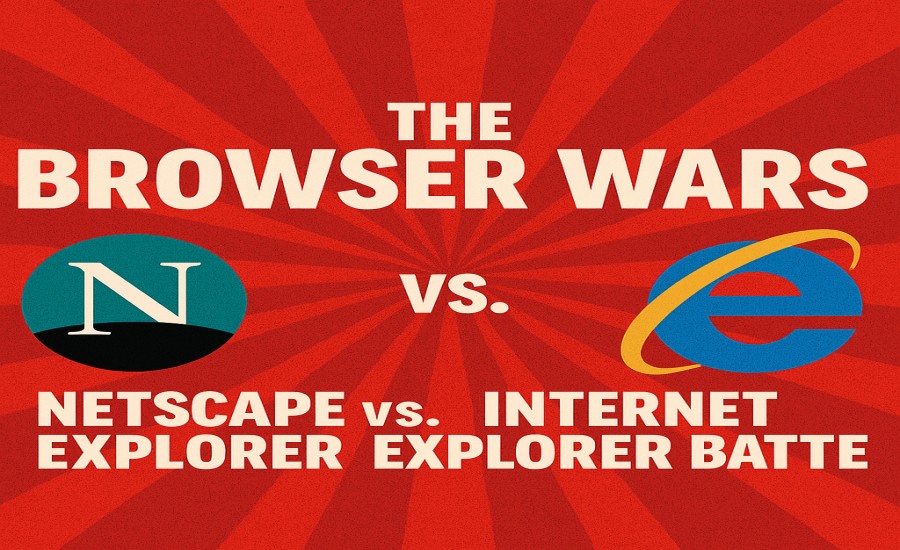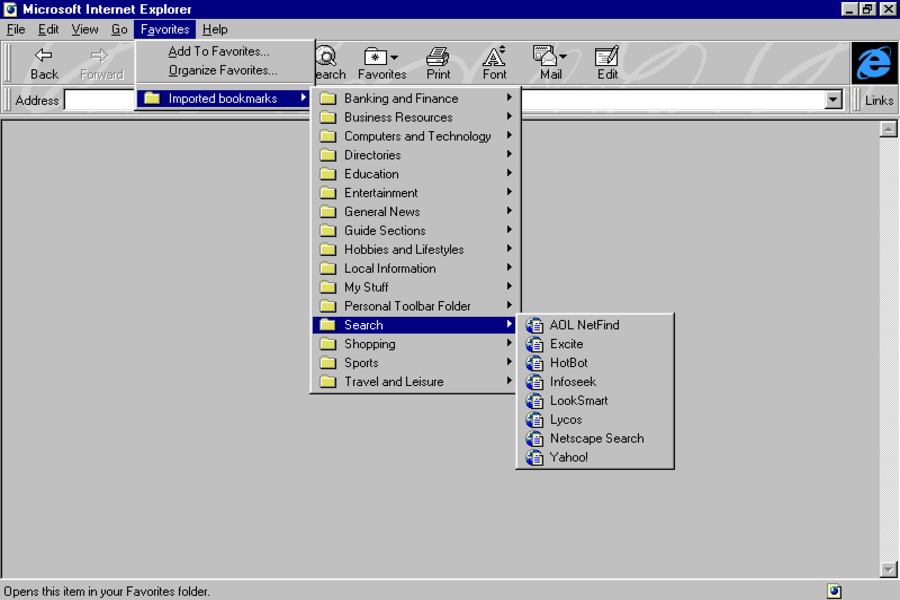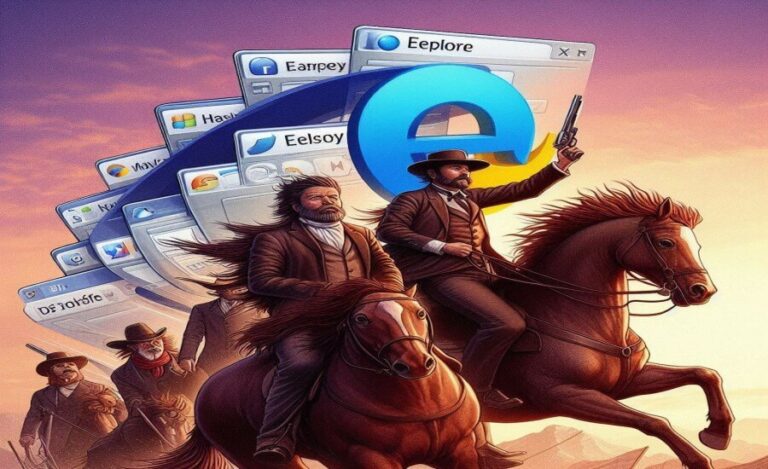
Cast your mind back to the mid-1990s. The World Wide Web was a new frontier, dialing up through screeching modems onto chunky CRT monitors. Websites were simpler, often built with basic HTML, but the potential felt limitless. In the early days of the internet, the battle for browser dominance sparked one of the most defining tech rivalries of the 1990s — the browser wars – Netscape vs Internet Explorer.
And your portal to this burgeoning digital universe? Your web browser. For a brief, incandescent period, one name reigned supreme: Netscape Navigator. But a giant was awakening in Redmond, Washington, setting the stage for one of tech history’s most famous conflicts – the first Browser War.
The Genesis Era: Mosaic and the Dawn of the Graphical Web (Early 1990s)

Before the war, the web was largely the domain of academics and tech enthusiasts, navigated often via text-based browsers like Lynx. The breakthrough came with NCSA Mosaic (1993), developed at the University of Illinois Urbana-Champaign.
Led partly by a young student named Marc Andreessen, Mosaic was revolutionary because it was easy to install and, crucially, displayed images inline with text, making the web visually engaging for non-technical users. It sparked the first internet boom.
Andreessen, along with Silicon Graphics founder Jim Clark, saw the immense commercial potential. In 1994, they founded Mosaic Communications Corporation (soon renamed Netscape Communications). Their goal: create a polished, commercially viable browser based on the Mosaic concepts.
Tech Spotlight: NCSA Mosaic (1993)
- Innovation: First widely adopted graphical web browser. Displayed images inline with text. Relatively easy to use and install on popular operating systems.
- Impact: Credited with popularizing the World Wide Web beyond academia and technical circles. Paved the way for Netscape Navigator.
Parallel Developments
The internet was transitioning from a government/academic network to a commercial space. Early internet service providers (ISPs) were emerging. Operating systems were still largely text-based or had rudimentary graphical interfaces (Windows 3.1).
User Experience Snapshot
Browse was often slow (dial-up!), but seeing images appear alongside text felt magical compared to text-only interfaces. Finding websites involved directories like Yahoo! or word-of-mouth; search engines were primitive. The web felt small, experimental, and exciting.
The Breakthrough Years: Netscape’s Meteoric Rise (1994-1996)

In late 1994, Netscape released its browser (initially Mosaic Netscape 0.9, then Netscape Navigator). It was faster, more stable, and packed with innovative features compared to Mosaic. Crucially, it introduced features “on-the-fly” – displaying text and graphics as they downloaded, making dial-up Browse far less tedious. Netscape Navigator was an instant sensation.
Available initially for free for non-commercial use, its adoption was explosive. By 1995-1996, Netscape commanded an astonishing market share, estimated between 80% and 90%. Netscape wasn’t just a browser; it was the internet experience for most people.
The company’s IPO in August 1995 was legendary, signaling the start of the dot-com boom. Netscape continued innovating rapidly, introducing key web technologies like JavaScript (allowing dynamic website behavior), cookies (for storing user data), and frames (dividing pages into sections).
Tech Spotlight: Netscape Navigator 1.0 – 3.0 (1994-1996)
- Key Features: On-the-fly page loading, JavaScript, Cookies, Frames, integrated Email/Newsreader (in Gold/Communicator versions).
- Market Share: Peaked at ~90%.
- Impact: Defined the early web Browse experience, drove web technology innovation, became the de facto standard. Its success put immense pressure on competitors.
Milestone Markers
- 1994 (Oct/Dec): Mosaic Netscape 0.9 / Netscape Navigator 1.0 released.
- 1995 (Aug): Netscape IPO signifies dot-com boom start.
- 1995 (Dec): Netscape introduces JavaScript (as LiveScript, quickly renamed).
- 1996: Netscape Navigator 2.0 & 3.0 released, solidifying dominance.
User Experience Snapshot
Using Netscape felt like having superpowers. The web came alive with dynamic elements thanks to JavaScript. Bookmarking favorite sites was easy.
The animated ‘N’ logo (the “throbber”) showing page loading activity was iconic. For most, Netscape was the internet. Do you remember downloading and installing it, perhaps from a magazine cover disk?
The Refinement Period: Microsoft Awakens (1995-1997)

Microsoft, initially slow to recognize the internet’s potential, quickly realized the threat Netscape posed. If the browser became the primary platform, Windows’ dominance could be undermined. In a famous 1995 memo titled “The Internet Tidal Wave,” Bill Gates pivoted the company to focus intensely on the internet, declaring Netscape a competitor to “match and beat.”
Microsoft licensed Mosaic code from Spyglass, Inc. to create Internet Explorer (IE) 1.0, released with Windows 95 Plus! pack in August 1995. IE 1.0 and 2.0 were widely considered inferior to Netscape Navigator. The turning point came with Internet Explorer 3.0 (August 1996).
It was the first version to seriously challenge Netscape, offering comparable features like JScript (Microsoft’s JavaScript implementation) and early support for Cascading Style Sheets (CSS), plus controversial proprietary tech like ActiveX. Crucially, Microsoft made IE 3.0 free and began bundling it with Windows 95 OSR2. The war was on.
Tech Spotlight: Internet Explorer 3.0 (1996)
- Key Features: JScript, CSS support, ActiveX, free of charge, bundled with Windows versions.
- Impact: Marked Microsoft’s serious entry into the browser war. Its feature set and free distribution model began to erode Netscape’s market share. It signaled Microsoft’s willingness to leverage its Windows monopoly.
Parallel Developments
Windows 95 becomes the dominant desktop OS. The dot-com bubble continues to inflate. Web design starts evolving beyond simple HTML, incorporating JavaScript for interactivity and CSS for better styling.
Price Point Perspective
Netscape Navigator, while free for academic/non-profit use, technically required a license for commercial use (though loosely enforced initially).
Internet Explorer was completely free and increasingly integrated into the operating system most people were already using. This cost difference became a significant factor.
User Experience Snapshot
You now had a choice, albeit one heavily influenced by what came with your PC.
IE 3.0 felt like a viable alternative to Netscape 3.0. Websites started experimenting with CSS and JavaScript, sometimes leading to pages looking or behaving differently depending on which browser you used – the first signs of web fragmentation caused by the war.
The Revolution: The Heat of Battle & IE’s Ascent (1997-1999)

The conflict escalated dramatically. Microsoft released IE 4.0 (1997), which was deeply integrated into the upcoming Windows 98 operating system, blurring the lines between browser and OS via features like the Active Desktop.
It also introduced Dynamic HTML (DHTML), enabling more complex web page animations and interactivity. Microsoft engineers famously dropped a giant IE logo ‘e’ on Netscape’s lawn, a brazen declaration of war.
Netscape responded with Netscape Communicator 4.0 (1997), bundling the Navigator browser with email, newsgroup, and web authoring tools. However, Communicator 4.x became known for being slower, buggier, and having poorer, non-standard support for emerging technologies like CSS and DHTML compared to IE 4/5.
Websites increasingly displayed “Best viewed in Internet Explorer” messages, and users encountered compatibility issues.
Microsoft aggressively leveraged its Windows monopoly: bundling IE, making it difficult to uninstall, striking deals with OEMs and ISPs to promote IE over Netscape.
This strategy, combined with Netscape 4.x’s technical stumbles, caused Netscape’s market share to plummet rapidly. By the end of 1998, IE had overtaken Netscape.
Tech Spotlight: Internet Explorer 4.0 & 5.0 (1997-1999)
- Key Features: Deep Windows integration (Active Desktop), improved DHTML, CSS, and JScript support, faster rendering (compared to Netscape 4). Continued free bundling.
- Impact: Decisively shifted market share momentum in Microsoft’s favor. Its tight OS integration became a central point in the subsequent antitrust case.
Antitrust Storm Clouds
In May 1998, the US Department of Justice and 20 state Attorneys General filed a landmark antitrust lawsuit against Microsoft, alleging it illegally used its Windows monopoly to stifle competition in the browser market, primarily targeting Netscape.
What We Gained / What We Lost
- Gained: Rapid feature innovation (DHTML, improved CSS/JS) driven by intense competition. Browsers became free.
- Lost: Web standards suffered as both companies pushed proprietary extensions. Website compatibility became a major headache for users and developers. Netscape’s market viability crumbled.
User Experience Snapshot
This was a frustrating time for web users. You often needed both browsers installed to view all websites correctly. Pages would break, scripts would error out.
Choosing a browser felt less about preference and more about which one worked with the sites you needed. IE’s integration meant it was just there on every new Windows PC.
The Aftermath/Modern Landscape: IE’s Reign, Netscape’s Legacy (Late 1990s – Present)

Microsoft had effectively won the first browser war by the turn of the millennium. IE 5 and later the infamous IE 6 (2001) achieved near-total market dominance, exceeding 95% share at its peak. Netscape, acquired by AOL in 1998 for $4.2 billion (a figure later revised), struggled to remain relevant. Browser development largely stalled under AOL.
However, Netscape made a crucial move before its acquisition: in 1998, it open-sourced the Communicator code base, leading to the creation of the non-profit Mozilla Organization. This group would eventually use the modernized Gecko rendering engine, derived from the Netscape code, to create Mozilla Firefox (released 2004).
The antitrust case against Microsoft concluded with rulings that Microsoft had engaged in monopolistic practices, but the remedies imposed (mostly behavioral restrictions) did little to immediately change IE’s market dominance. This dominance, however, led to stagnation.
With no significant competition, Microsoft drastically slowed IE development after IE6, leading to security vulnerabilities and lagging support for evolving web standards, frustrating web developers for years.
The legacy of this war is complex. It spurred rapid web tech innovation but also caused fragmentation. It led to a near-monopoly that hindered progress for years.
But it also resulted in the open-sourcing of Netscape’s code, directly leading to Firefox, which reignited browser competition and ushered in the second browser war against IE, eventually joined by Google Chrome. AOL officially discontinued support for the Netscape browser line in 2008.
Tech Spotlight: Mozilla Firefox (Derived from Netscape code, 2004)
- Origin: Developed by the non-profit Mozilla Organization using the open-sourced Netscape codebase (Gecko engine).
- Impact: Provided the first significant challenge to IE’s dominance after the first browser war ended. Championed web standards, security, and user choice, paving the way for renewed browser competition.
Heritage Impact
The first browser war fundamentally shaped the web. It established JavaScript and CSS as core web technologies, highlighted the power (and danger) of platform bundling, led to a major antitrust case, and ironically, sowed the seeds of its winner’s eventual decline through the open-sourcing of the loser’s code.
It’s a critical case study in tech competition, strategy, and the tension between innovation and standards.
Full Circle Reflections
The journey began with Netscape democratizing the graphical web, achieving incredible success through innovation. Microsoft’s forceful response, leveraging its OS dominance, led to a fierce battle that pushed web technology forward rapidly but ultimately crushed the pioneer.
Yet, from Netscape’s ashes rose Mozilla, ensuring that the fight for an open, competitive web landscape would continue. The echoes of this war still resonate in today’s multi-browser world.
FAQ: Decoding the Browser Wars
- What started the first browser war?
It began when Microsoft, seeing the rapid success of Netscape Navigator and the potential threat to Windows, decided to aggressively compete by developing Internet Explorer, bundling it for free with Windows, and rapidly adding features. - Who won the Netscape vs. Internet Explorer war?
Microsoft’s Internet Explorer decisively won, achieving over 95% market share by the early 2000s and leading to Netscape’s decline and eventual discontinuation. - Why did Netscape lose?
Key factors included: Microsoft bundling IE for free with the dominant Windows OS, technical stumbles with Netscape Communicator 4.x (bugs, poor standards support), Microsoft’s deals with OEMs/ISPs, and Netscape being financially outmatched. - What was the US v. Microsoft antitrust case about?
The US government sued Microsoft for illegally using its Windows monopoly to maintain dominance, specifically citing the practice of bundling Internet Explorer with Windows to stifle competition from browsers like Netscape. Microsoft was found to have engaged in monopolistic practices. - What was JavaScript’s role in the war?
Netscape invented JavaScript to add interactivity to web pages. Microsoft reverse-engineered it as JScript. Both browsers rapidly evolved their implementations, leading to early inconsistencies but establishing JavaScript as a fundamental web technology. - Is Netscape still around?
No. After being acquired by AOL, development languished, and AOL officially discontinued the Netscape browser line and support in 2008. However, its code lives on through the Mozilla project and Firefox.





